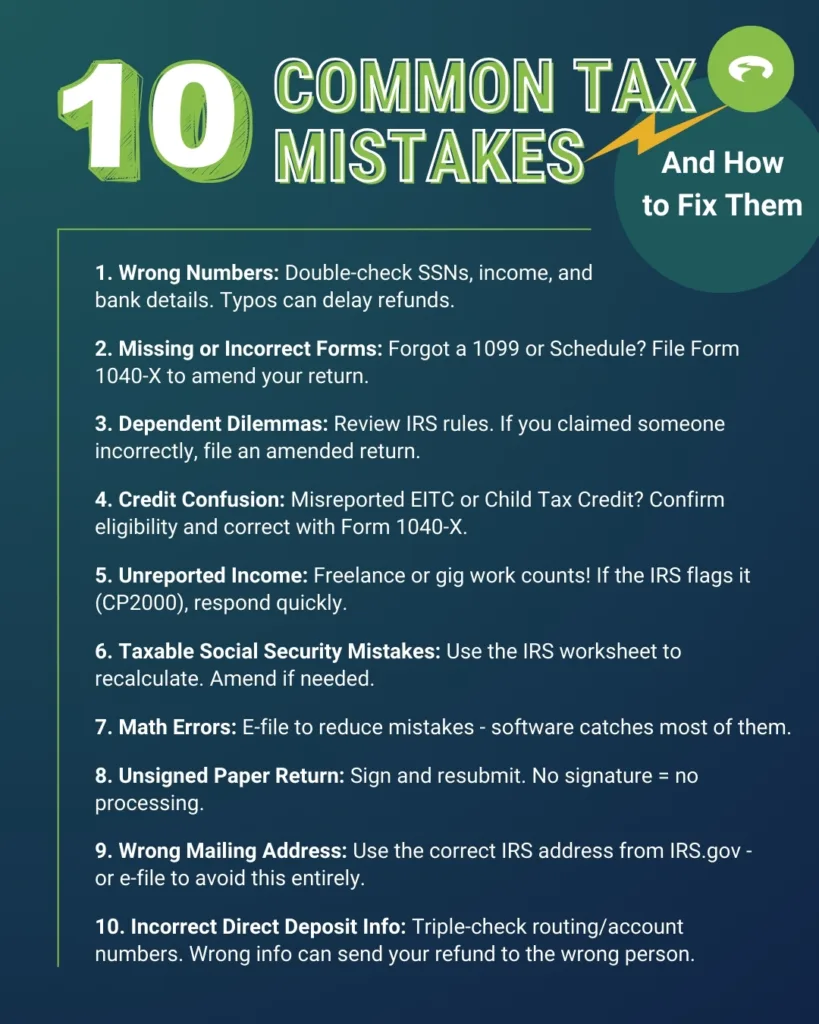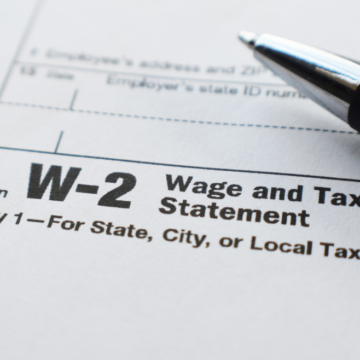Taxes are complicated. Between deductions, dependents, credits, and changing rules, it’s no wonder millions of people turn to professionals. But even if you’re filing solo, avoiding these common missteps can save you a lot of trouble. And if you need to file an amendment (or haven’t filed yet at all), here are some helpful links to get you started:
Common Tax Mistakes
Incorrect filing status
Fix: If you used the wrong filing status, file an amended return (Form 1040-X). To avoid future mistakes, use the IRS Interactive Tax Assistant to find the correct status based on your situation.
Wrong or missing Social Security number(s)
Fix: Double-check your SSN and ensure it matches your legal name on file with the SSA. If already filed, use Form 1040-X to correct.
Missing forms or schedules
Fix: File an amended return to include any omitted forms (like 1099s, Schedules A, C, or D). Tax software often alerts you to these before you file.
Unsigned return
Fix: For paper returns, sign and re-submit. If you filed electronically and your PIN or e-signature failed, check with your e-file provider or the IRS.
Claiming ineligible dependents
Fix: Review IRS dependent eligibility rules. If a dependent was denied, gather documentation and file Form 1040-X if needed.
Misreporting tax credits (e.g., EITC, Child Tax Credit)
Fix: If the IRS questions a credit, review your eligibility and file an amended return if necessary. Claiming certain credits may delay refunds under the PATH Act.
Unreported income (freelance, gig work, investments)
Fix: If the IRS sends you a CP2000 notice, compare it to your return. If correct, pay the difference. If not, respond with documentation. You can also file Form 1040-X if needed.
Wrong taxable Social Security benefits
Fix: Use the IRS worksheet or software to calculate how much of your benefits are taxable. File a 1040-X if you need to correct it.
Math errors
Fix: The IRS often corrects simple math mistakes, but they can still delay your refund. Reduce errors by filing electronically.
Sending it to the wrong IRS address (paper filers)
Fix: Re-send your return to the correct address listed on IRS.gov. Better yet: file electronically.
Standard deduction vs. itemizing
Fix: If you discover itemizing would have saved more, file a 1040-X with Schedule A. You have up to three years to amend and claim a refund.
Incorrect bank account info for direct deposit
Fix: If you entered an invalid account, the IRS will mail a paper check. If the account was valid but incorrect (e.g., someone else’s), contact your bank and the IRS. The IRS can’t reverse deposits once processed, so triple-check routing/account numbers before filing.
How to Stay on Track When Filing Taxes
Double-check your numbers
Filing electronically reduces math errors and flags inconsistencies. Review line by line—especially SSNs and income.
Review all your info
Names, SSNs, and direct deposit info must be perfect. A single wrong digit can send your refund to the wrong place—or delay it.
Don’t miss the deadline
The tax deadline is April 15, 2025. If you need more time, file Form 4868 for an automatic extension. But remember: extensions apply to filing, not paying.
Claim your deductions and credits
You could qualify for savings on things like student loan interest, medical expenses, education, and child care. Research your options—or use a tax pro.
Use the right forms
Don’t mix up 1040, 1040-SR, or 1040-X. Use IRS guidance or tax software to select the correct ones automatically.
File even if you can’t pay
Filing late triggers harsher penalties than paying late. Submit your return and arrange a payment plan if needed.
Filing Past the Deadline: What to Do If You Made a Mistake
Mistakes happen! But correcting them quickly can help you avoid penalties or get a bigger refund. If you filed and later spot an error, here’s how to fix it:
How to Amend Your Tax Return
- Gather your original return and all relevant documents.
- Fill out Form 1040-X, clearly explaining what changed.
- Submit it electronically or by mail.
- Pay any additional tax due—or request a refund if you overpaid.
If the issue stems from a W-2 or 1099 error, contact the issuer to request a corrected form first.
Fixing a tax mistake isn’t fun, but it’s better than facing delays, penalties, or missed refunds. Take the time to file carefully, and when in doubt, reach out to a tax pro or visit www.irs.gov.

You Might Also Be Interested In…
Making the Most of Your Tax RefundMaking the Most of Your Tax Refund
What You Will Learn
- The role behavioral economics plays in how you handle your refund
- How to prioritize these dollars to strengthen your financial foundation
- Strategies for prioritizing based on your financial goals
GreenPath Financial Service
GreenPath, A Financial Resource
If you’re interested in building healthy financial habits, paying down debt, or saving for what matters most, take a look at these free financial tools.










